by Brian Hioe
語言:
English
Photo credit: tomscy2000/Flickr/CC BY 2.0
ANDRE BECKERSHOFF’S Social Forces in the Re-Making of Cross-Strait Relations is a useful look at the backdrop of events that later led to the 2014 Sunflower Movement.
In particular, Beckershoff’s monograph examines the period of cross-strait rapprochement that led to the eruption of the Wild Strawberry Movement and, after it, the Anti-Media Monopoly Movement. From there, Beckershoff goes on to discuss how structures that emerged from the two movements later influenced the Sunflower Movement.
As the Sunflower Movement is not Beckershoff’s main focus, Social Forces in the Re-Making of Cross-Strait Relations is an important contribution to examining the preceding series of events. Political developments in the aftermath of the Sunflower Movement and popular backlash against the Cross-Strait Services Trade Agreement it demonstrated have, in many ways, come to shape how this period is examined retrospectively.

Photo credit: 笨笨的小B/WikiCommons/CC BY-SA 2.0
As such, the focus on the 2000s and 2010s in its own right is a useful addition to the English-language academic literature. While less the focus of the book, the gloss on the socioeconomic context that led to rapprochement between elites in Taiwan and China, as well as growth in economic interdependence, is still highly useful. The outlining of the large conglomerates that have come to play a preeminent role in cross-strait economic integration–tracing out their stances on Taiwan’s political and economic relationship with China– proves highly useful.
In particular, Beckershoff views political shifts in the Ma administration as, in ways, an interplay between social movement, business, and government actors. Taking a Gramscian perspective, then, this means a read on the period as a dance between hegemonies and counter-hegemonies of various sorts. For example, Beckershoff takes the view that it was in response to the eruption of the Wild Strawberry Movement in 2008 that there was a “cultural turn” by cross-strait elites toward promoting positive views of China in Taiwan, through what critics termed “Media Monopoly.”
In turn, the structures that developed through the Wild Strawberry Movement and Anti-Media Monopoly Movement contributed to the outcome of the Sunflower Movement. This is on a number of levels, such as regarding the focus in the Sunflower Movement on key personality figures, or even the marginalization of radical politics in the movement.
The Anti-Media Monopoly Movement. Photo credit: tenz1225/WikiCommons/CC BY-SA 2.0
Beckershoff does a good job of tracing the different trajectories of overlapping structures and organizations between the different movements. To this extent, Beckershoff’s interpretive frame for the movement, and for the overall socio-political context that shaped this period is theoretically sophisticated and insightful, focusing more on the larger context than on individuals or contingent events. Nonetheless, though Beckershoff interviews both academics, officials, and activists, it does appear as though the work still slants toward a focus on social movement actors.
Thus, Beckershoff’s work is a strong and insightful addition to the existing literature on the period, then. The book does a great deal in deepening the literature in English about the 2000s and 2010s in Taiwan. Moreover, it continues to be relevant as reading for contemporary times, seeing as many of the social forces that were salient during this period still influence contemporary Taiwanese society.




